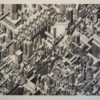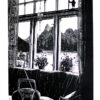What is the connection between Sunderø Gallery artist Marius Martinussen, gladiators and Voss? Bear with us, and we´ll explain.
Gladius was the Latin word for the ancient Roman foot soldier’s primary sword. As follows, a gladiator was a swordsman. An armed combatant who entertained audiences in the Roman Circus, fighting against other gladiators or wild beasts. The origin of the combats is open to debate, but they became immensely popular and were an essential feature of politics and social life in the Roman world between the 3rd century BC and 2nd century AD. The games finally declined during the early 5th century after the adoption of Christianity as state church of the Roman Empire in 380.
Most of the gladiators were despised as slaves, and schooled under harsh conditions. Still, some were volunteers who risked their lives and their legal and social standing by appearing in the arena. Irrespective of their origin, gladiators offered spectators an example of Rome’s martial ethics and, in fighting or dying well; they could inspire admiration and popular acclaim.
But what has this tradition of celebrating deadly combats to do with a school in western Norway and an artist, not particularly known for his fighting skills? Well, in the small village of Voss, surrounded by wild mountains and known among many things for hosting some major Norwegian winter sports warriors, there is this high school called Voss Gymnas.
The school offers a varied education program, including studies in sports like soccer, handball and skiing games, as well as specialization in elite sports as alpine, freestyle, cross country skiing and biathlon.
Voss Gymnas is approaching it´s 100 years jubilee, and stands before an extensive expansion and modernization. And finally, we reach the explanation; the hallway between the school and the football field is called the Gladiator´s hallway. On these walls Marius Martinussen is going to mount 75m2 painted, perforated steel sheets. On planning his large-scale artwork, he has taken inspiration from the name of the hallway, naming it Gladius. The name both refers to the steel of the plates, the abstract colourful paintings mimicking a sword dance, and the zigzag mounting. The plates are still under construction, and the artist will start working on them as soon as they are cut. The work will be done in his studio, and the plates will be transported to Voss for mounting later this year.
Martinussen has also done commissioned works at Randers Statsskole in Denmark, St. Olavs Hospital in Trondheim (NO) and Kjell Henriksen Observatory (Svalbard).
(Photos courtesy of the artist Marius Martinussen)




